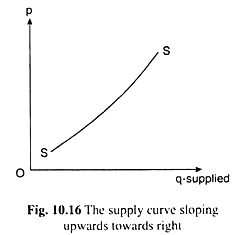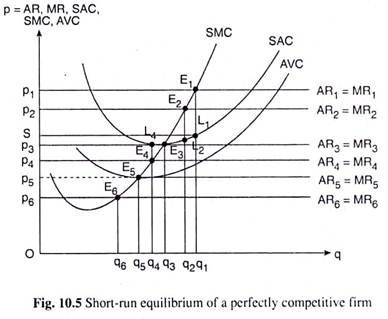In this article we will discuss about the law of supply, explained with the help of a suitable diagram.
The quantity of a good that is sent per period to the market for sale at any particular price, is called the quantity supplied of the good. In our discussion of the short-run and long-run supply curves of a perfectly competitive industry, the supply of the product of the industry depends upon its price.
This relationship of dependence between the quantity supplied of a good and its price is known as the law of supply. Apart from price, the supply of a good depends on many other factors.
Some of them are cost of production of the good, method of production of the firms producing the good, the business organisation of the firms, nature of the good, i.e., its perishability or its lumpiness, the length of time obtained for effecting changes in supply, etc.
ADVERTISEMENTS:
Now, we may describe the law of supply in this way. All other determinants of supply remaining the same, if only the price of a good increases or decreases, then the quantity supplied of the good, in general, will also increase or decrease. Therefore, owing to the law of supply, the supply curve of a good would, in general, slope upwards towards right like the SS curve in Fig. 10.16.
While discussing the law of supply, we have to remember in the very beginning that the nature of supply of a good may be of three types depending on the length of time given to effect changes in supply.
These types are:
ADVERTISEMENTS:
(i) Supply in the very short-period market,
(ii) Supply in the short-period market, and
(iii) Supply in the long period.
(i) Law of Supply in the Very Short-Period Market:
The law of supply is not effective in the very short-period market. For, very short period is such a short span of time during which the quantity supplied of the good cannot, in general, increase or decrease in response to an increase or decrease in its price. We have discussed this point.
ADVERTISEMENTS:
(ii) Law of Supply in the Short-Period Market:
However, the law of supply works in the short-period market. If the price of a good increases or decreases, then in response to that, the producer is able to increase or decrease his quantity supplied in the short run by using more of the variable inputs.
While discussing about the short-run supply of competitive firm, the SRS curve of the firm is nothing but the portion of its SMC curve that lies on and above its AVC curve. Therefore, the SRS curve of the firm is upward sloping, i.e., in the short run, the law of supply does work.
The reasons for the firm’s SRS curve to be upward sloping are:
(a) The Law of Variable Proportions (LVP):
Owing to this law, the short-run marginal cost (SMC) curve of the firm is U-shaped and we obtain the upward sloping portion of the SMC curve.
(b) The Firm’s Goal of Profit Maximisation:
The first order condition (FOC) for profit maximisation of a competitive firm is p = SMC [eq. (10.12)] and the second order condition (SOC) is that the SMC curve of the firm should be upward sloping. Therefore, in order to have maximum profit, the firm would have to select that point of intersection of its p = AR = MR line and its SMC curve where the latter is upward sloping or positively sloped.
For example, in Fig. 10.5, at p = p1, the firm would have to supply q = q1 at the point E1 on the upward sloping portion of the SMC curve. Similarly, at p = p2 or at p = p3, the firm’s supply would be q = q2 or q = q3, respectively, at the points E2 or E3. Therefore, the firm’s SRS at different prices are obtained along the upward sloping segment of its SMC curve.
ADVERTISEMENTS:
It clearly follows from the above analysis that the SRS curve of a firm is obtained to be upward sloping towards right owing to both the law of variable proportions and the firm’s goal of profit maximisation. We have to remember in this connection that if the price of the good (p = AR) is less than its average variable cost (AVC), the firm would shut down its production and its quantity supplied would be reduced to zero.
Therefore, for the supply to be positive, we should have p = AR ≥ AVC. That is, for positive supply, the firm’s SRS curve is that upward sloping portion of its SMC curve which lies on and above its AVC curve. In Fig. 10.5, this portion of the SMC curve is E4E3E2E1 . . ., which is, therefore, the firm’s SRS curve for positive supply.
The causes of the firm’s SRS curve to be positively sloped or of the law of supply to be effective in the short run. Now, the SRS curve of the industry is the horizontal summation of the SRS curves of individual firms. That is why the SRS curve of the industry would also be positively sloped.
ADVERTISEMENTS:
Also, the SRS curve of the industry means the SRS curve of the good produced by the industry. Therefore, in a perfectly competitive market, the SRS curve of the good sold is upward sloping, i.e., in the short run, the law of supply is effective.
(iii) Law of Supply in the Long-Period Market:
The LRS curve of an increasing cost industry will slope upward towards right, i.e., the law of supply will work in this case. However, in the case of decreasing cost and constant cost industries the LRS curve will be a downward sloping curve and a horizontal straight line, respectively. In these cases, we shall get exceptions to the law of supply.
In the increasing cost industry the good is produced under increasing cost conditions. That is why, ii response to an increase in demand and the price of the good, more can be supplied in the long run only at a higher price. Therefore, the law of supply is effective here because costs are rising.
In the decreasing cost industry, on the other hand, more of the goods can be supplied in the long run at a lower price because costs are decreasing, and so the law of supply is not effective here. Lastly, in the constant cost industry, more of the goods can be supplied in the long run at the same price, because, here, the costs are constant, and so the law of supply is not effective here.
ADVERTISEMENTS:
At the end of our discussion of the law of supply, we may conclude that the law is not effective in the very short period, it is effective in the short period, and, in the long period, it is effective under increasing cost conditions and it is not effective under decreasing and constant cost conditions.

